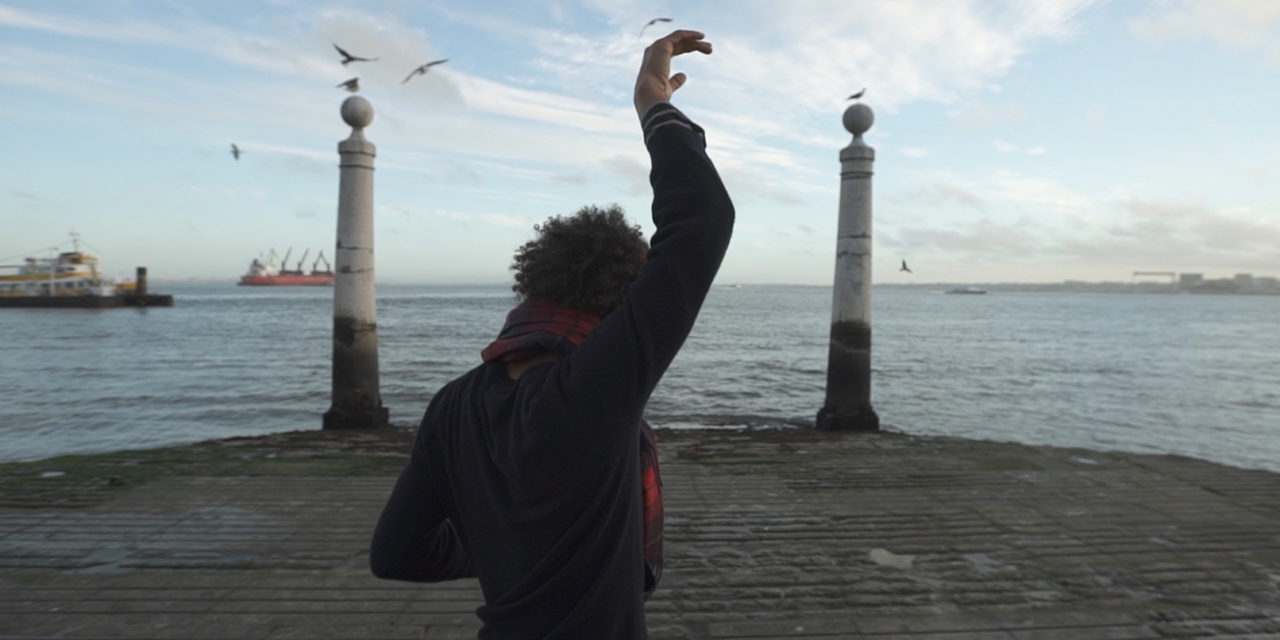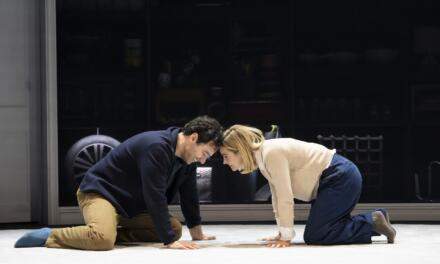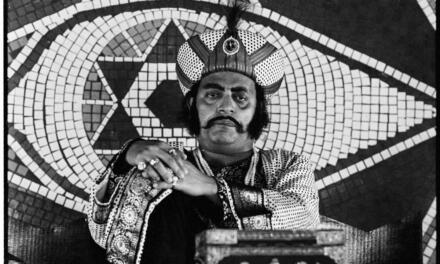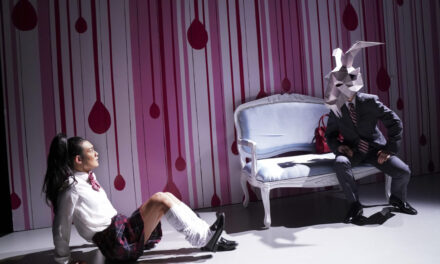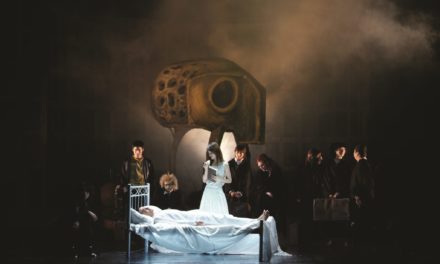It was Southern summer, but winter up North when Brazilian artist collective Aisthesis traveled to Lisbon looking forward to leaping into the world. They borrowed winter coats from friends and family so as challenged their own limits (geographic limits at first) by taking that essential millenarian adventure called traveling, as primitive as mankind’s migration and settlement throughout continents. They booked a Portuguese house as a home, flew over the night, and stood in line for one hour and a half in the immigration queues to finally join Vera Mantero for one month, for six hours a day at her Espaço da Penha studio in the old continent.
The attitude of leaping into the world is potentially present in every traveling experience. In the book Camminare, Una Rivoluzione (Walking, A Revolution), Italian writer Antonio Labbucci (2013, p. 10) quotes Hofmannsthal to remind us that all human beings can only find out in the world the things they have already got within themselves. However, they still need the world to do so. In other words, one should leap into the world to trigger processes that will turn their very own smoldering subjective strength into a powerful discovery. For a travel should be a chance to learn new manners to proceed in daily life–one might eat as usual, however food will taste differently; one might dance, as usual; however it is going to happen on a different floor; one will cross a street, as usual; however it may take a little more patience–or a little less–to do so. Since one learns new ways to proceed in regular life, they also learn how to unfold their own selves.
“(…) traveling allows us the chance to develop all five senses: feeling and listening more deeply; looking and seeing more intensely; tasting and touching more carefully–an unquiet body, tense and open to new experiences, processes more information than usual.” (Michel Onfray–The Theory Of Travel)
What was about to be delivered? We had been introduced to Vera back in 2015 during an immersion workshop held in Brasilia (Brazil). In Lisbon, our approach to her focused on two primary goals in mind: firstly, to resume from the point we had stopped our thoughts and practices on attentive listening and presence for the Performing Arts; and secondly, to have Vera as a director in the creation of duets meant to be parts of a future play yet to be staged.
Many writings on the theory of travel depict the archetypical dynamics that emerge between foreigners and hosts. Once in Lisbon, we felt like living these dynamics, looking over stories that would bring us closer to each other and would make us feel like being constantly displaced. As a host, Vera managed to listen, to feel us, to illuminate our subjects, revealing which were our very own expectations far away from home. Featuring her typical stream-like-synthesis ability, she inquired about motivation, desires, themes of interest, aesthetic choices, and procedures which would address the range of our ideas in that particular moment. Then she led us to pick three keywords which were about to become a central theme throughout the residency: fight, resistance, and hope.
How should this all be delivered? Our creative process unfolded in a very collaborative way. We first scheduled our time together in three primary activities: (1) a deep approaching to the theme–which we accomplished by means of interviewing artists, watching videos, and reading; (2) practicing six hours a day at live sessions based on improvisation featuring selected themes; and (3) trying to compose with materials we delivered at live sessions. All three steps were taken simultaneously during the whole process. Furthermore, our collective of researchers was interested in holding to its original hybrid “nondisciplinary” practice without any hierarchies between mediums of expression and artists. We wanted to keep it coherent to the notion of current flow we had described in the very beginning of this research. On the other hand, we were also interested in getting to know different procedures which Vera herself would end up suggesting.
We proceeded to step number one by visiting our collaborators at their working places. First, we met social activist João Azevedo in a cozy Fair Trade store he used to run at Saldanha neighborhood. After that, we met literary critic António Guerreiro, who was a professor at Faculdade de Belas Artes (College of Fine Arts) at the University of Lisbon. Lastly, writer, philosopher, and professor Gonçalo M. Tavares came to see us in our temporary Portuguese house. Somehow, each one of them was able to approach elements or aspects concerning our central theme (fight, resistance, and hope), besides bringing on new references, new images and new possibilities to be unfolded. We also watched a very touching video in which Portuguese writer Rui Nunes is interviewed as well as the British motion picture I, Daniel Blake, to name but two. We pursued to include both perspectives of macro politics–the greatest decisions, the greatest revolutions–and micro-politics–the impact of politics on our intimate daily life, our closest relations–in our work. The more time passed by–and time was short–the more we understood how explicitly political our approach was becoming.
João Azevedo, António Guerreiro, Gonçalo M. Tavares, Rui Nunes,
To visit our first interviewees, we walked. No car, no buses, but walks. Taking group walks soon became an artistic procedure. Several different materials arouse during our group walks–pictures, sounds, textures of movement, poetic writings, dialogues, videos, situations up to be improvised. Once we realized how relevant such procedure could turn out to be, we started to constantly move from the workroom to the skies. Well, if the concept of artistic residency contains a perspective of traveling as an experience within, would six hours a day inside a workroom be enough to accomplish such process? How would those six hours–which are necessary for an actor or a dancer to prepare (since the work relies on their own body)–be either different in Dubai or Lisbon? Or Brasilia? How would such bodies bring inside the workroom the light they were exposed to in certain places, for example? Or the musical line we hear when people speak out in the streets? From this point on, we then realized we needed to include the “sky” and bring it into the workroom. For we lived together, we cooked together, we practiced together, and now we could eventually walk together as a creation procedure and a poetic trigger to think our theme in connection to daily life.
As the program moved forward, we took eventual breaks to watch videos featuring materials we had improvised previously, both in the workroom and out in the streets. During all-day-long group video sessions, we made a selection of the most interesting materials: transcriptions, remarkable characters, improvisational dynamics, relations, scenes under construction almost ready to be staged. It is worth it to emphasize the role the camera played throughout the residency program. Shots were not necessarily long concerning field size. A first cut would be performed while shooting by choosing specific angles. That’s why during the selection breaks we edited extracts which had already been selected by the cameraman’s eyes and position. He suddenly became an extra author adding a spare layer to the work, as well as some extra noise. Moreover, through film language we managed to look at the sky properly and bring it into the workroom alongside the taste and flavor of meals, the traffic outdoors and through Lisbon’s huge roundabouts, the accent we hear when unintentionally we bump into pedestrians, and also the classic view of old men in their long coats at sunny chilly squares. There were also personal notes and diaries to be checked once in a while, by observing the results of such an enriching interaction.
We then started to define artistic residency by using this metaphor to conceive an artistic practice which takes place between the “workroom and the skies” of a foreign city. A residency can also be a chance to invest time in qualified activities related solely to creation. By having no ordinary tasks to interrupt the artists’ daily routine, some interesting themes, techniques, and procedures will probably arise. One learns how to negotiate between hours spent inside the room (since theatrical creation demands such discipline) and hours spent under the sky. Artists may live together in an immersion situation and will continue to exchange and affect each other at their shared temporary home. Differences, similarities, and preferences of each artist as a single being are emphasized. The space-time of creation is optimized.
What is about to be kept? Answering such a question seems as hard as attempting to count the priceless legacy to be left by such a meaningful encounter. During our residency time, we did not manage to deliver a final version out of several scenes under construction we had prepared. That only happened six months later when each artist, including Vera Mantero herself, came up with a personal script version. Many staging suggestions have been well accepted so we could actually keep this process going on, back in Brazil.
What with one thing and another that remains in our vivid memories, there are some series of scenes under construction, script versions, hours on film, and creative approaches. On the other hand, there is that memorable day we walked together and stood in silence to watch the sunset at a park. There is also that typical Brazilian moqueca meal we cooked and served for dinner to our new Portuguese friends as a sign of gratitude. There is the sweet way Vera moved her hands through her hair while watching us improvise. There are those intriguing questions she kept asking us, and those intriguing questions we kept asking ourselves, without mentioning other uncountable special moments we experienced during this immersion time together.
If when traveling we look forward to leaping into the world so we could find out what we have within ourselves, meeting Vera inspired our political engagement and contestation, our faith on the power of Arts and its discourse. It provoked us to set our inward dance as well as our technical skills: act and counteract, presence, instant; increased our repertoire of procedures to compose; made us see ways to approach and register what we create through improvisation sessions.
How far will such experience take us as artists? How long will it influence the way we teach Arts? A possible answer to such questions: the sky is the limit! For encounters generate a certain potential of affections which enhances itself through time, the memory of the body and the body of memory.
References:
LABBUCCI, Antonio. Caminhar, Uma Revolução. São Paulo: Martins Fontes, 2013.
ONFRAY, Michel. Teoria Da Viagem: Uma Poética Da Geografia. Lisboa: Quetzal, 2009.
This post was written by the author in their personal capacity.The opinions expressed in this article are the author’s own and do not reflect the view of The Theatre Times, their staff or collaborators.
This post was written by Francis Wilker, Giselle Rodrigues, and Glauber Coradesqui .
The views expressed here belong to the author and do not necessarily reflect our views and opinions.

